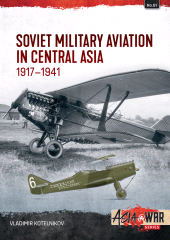Soviet Military Aviation in Central Asia 1917-41
58 p.
The utilization of air power by the Communist regime in Russia during the revolutionary period and civil war to control its territories in Central Asia is an intriguing aspect of military history often overlooked in Western narratives. The region, which bordered Iran, Afghanistan, and China, and included the ancient cities of Samarkand and Bukhara, held strategic significance for both the Russian Empire and the subsequent USSR. Attempts to impose Russian or communist ideologies on the indigenous tribal populations clashed with deeply rooted Islamic traditions, leading to resistance movements such as the Basmachi uprising.The Basmachi insurgency, viewed as defenders of traditional tribal values by the local populace, was perceived as mere banditry by the Russian and Soviet authorities. Policing such vast and challenging terrain, where environmental conditions posed significant hazards alongside armed opposition, necessitated innovative approaches. Consequently, the Soviets turned to air power as a means of con
trolling these remote regions.Despite inventive tactics, the aircraft employed by the Soviets in Central Asia during the inter-war period were often outdated, worn-out, or repurposed from other theaters of operation. This reliance on obsolete or marginal aircraft highlights the resource constraints faced by the Soviet military during this tumultuous period.Soviet Military Aviation in Central Asia: 1917-41 offers a detailed exploration of the inter-war use of air power in Soviet Central Asia, drawing from Russian-language sources and photographic archives. The book provides insights into the challenges faced by the Soviet military in maintaining control over the region, accompanied by rare photographs and unique color artworks depicting the aircraft utilized during this era. Through this lens, readers can gain a deeper understanding of the complexities of military strategy and conflict in Central Asia during the early twentieth century. [Publisher's text].
Special access authorizations may apply; please contact us for further information.
-
Informations
ISBN: 9781804516423
COLLECTION


